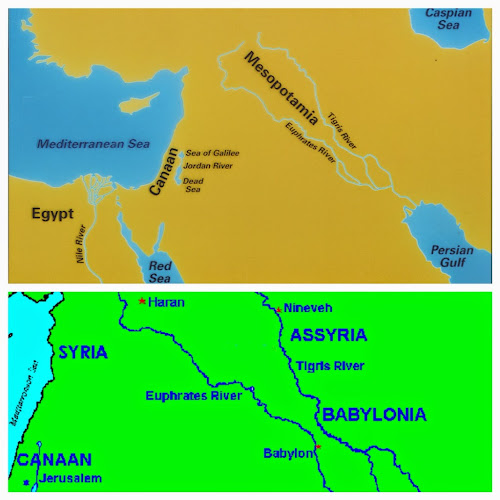The Assyrian Kings responsible for the fall of Israel
( King Solomon was the last King of a unified Israel.
Despite the awesome temple he built on Mount Zion, he loved women from nations that God had forbidden and he would have succumbed to the worship of their gods. He would have been guilty of syncretism ( religious infidelity)
He built temples for Moabite and Ammonite gods- this may reflect a tolerance for other cults or gods in the 10th & 9th centuries.
Of course there was discontent among the people and a huge class divide ( he was taxing them heavily too)
When he died in 931BCE, the kingdom was divided between King Jeroboam in the North & Rehoboam in the south. The northerners ( 10 tribes of Israel would not recognise Rehoboam as King. The King would not lessen the tax burden on the people either. Hence Jeroboam became King in the North and Rehoboam was King of south- the tribes of Judah and Benjamin) This account is in 1 Kings )
Tiglath-Pileser III ( pix 1 )
Reign 745–727 BCE
He introduced advanced civil, military, and political systems into the Neo-Assyrian Empire
Tiglath-Pileser III seized the Assyrian throne during a civil war and killed the royal family.
He introduced sweeping reforms which made the Assyrian army, already the greatest fighting force in the world since the 14th Century ( 600 years previously), the world's first professional standing army.
Tiglath-Pileser III subjugated much of the known world at the time!!
-In the south west, he subjugated Israel, Judah, Philistia, Samarra, Moab and Edom
Biblical records describe how Tiglath-Pileser III exacted 1000 talents of silver as tribute from King Menahem of the Kingdom of Israel (2 Kings 15:19) and later defeated his successor Pekah ( 15:29)
King Pekah of Israel had allied with Rezin, king of the Arameans ( Syria) against Ahaz of the Kingdom of Judah, who responded by appealing for the Assyrian monarch's help with the Temple gold and silver.
Tiglath-Pileser answered swiftly. He first marched his army down the eastern Mediterranean coast, taking coastal cities all the way to Egypt. This cut off his enemies' access to the sea.
Once this was achieved, he returned to the Northern Kingdom of Israel, destroyed their army, and deported the Reubenites, Gadites, and the people of Manasseh to Halah, Habor, Hara, and the Gozan river (1 Chron 5:26).
He then installed an Israelite puppet king, Hoshea, (732-723 BCE) in the place of king Pekah.
He concluded this extensive campaign by marching north and west, ravaging Aramaea, seizing Damascus, executing Rezin, and deporting the survivors to Kir (2 Kings 16:9).
Beyond this, the Assyrian alliance was not beneficial to Ahaz (2 Chron 28:20)
Isaiah & Micah were Judean prophets who talked about the Assyrian crisis
Shalmaneser V (pix 2)
was king of Assyria from 727 to 722 BC.
( Hoshea was King of Israel in this period)
According to 2 Kings, chapters 17-18, Shalmaneser accused Hoshea, King of Israel, of conspiring against him by sending messages to Pharaoh Osorkon IV of Egypt, and captured him.
Indeed, the Egyptians attempted to gain a foothold in Palestine, then held largely by Assyria's vassal kings, by stirring them to revolt against Assyria and lending them some military support.
After three year of siege he took the city of Samaria. The populations he deported to various lands of the empire, (together with ones deported about ten year earlier by Tiglath-Pileser III) are known as the "Ten Lost Tribes" of Israel.
The populations he settled in Samaria instead form, according to the commentary in the Bible, the origin of Samaritans. Shalmaneser died in the same year, 722 BC, and it is possible that the population exchanges were done by his successor Sargon II.
Sargon II ( pix 3 )
reigned 722 – 705 BC
Sargon II became the ruler of the Assyrian Empire in 722 BC after the death of Shalmaneser V.
It is not clear whether he was the son of Tiglath-Pileser III or a usurper unrelated to the -however he took the name Sharru-kinu ("true king"), after Sargon of Akkad — who had founded the first Semitic Empire in the region some 16 centuries earlier. ( we've talked about him)
Under his rule, the Assyrians completed the defeat of the Kingdom of Israel and exiled the inhabitants.
Sargon's name actually appears in the Bible only once, at Isaiah 20:1, which records the Assyrian capture of Ashdod in 711 BC.
He took 27,290 people captive from the city of Samaria resettling some with the Israelites in the Khabur region and the rest in the land of the Medes thus establishing Hebrew communities in Ecbatana and Rages ( these are all in modern day Iran)
Amos and Hosea were the prominent prophets in Israel during this crisis
Fall of the Assyrian Empire:
612BCE- A year after the death of the last strong Assyrian ruler, Assurbanipal, in 627 BCE, the Assyrian empire spiralled into a series of brutal civil wars. Babylon saw its opportunity and, with the help of allies, it sacked the capital city of Assyria, Nineveh in 612BCE. The Babylonians then became the big boys in the area.
Prophet Nahum celebrated the fall of Nineveh in his book
The Babylonian King responsible for Judah's fall:
Nebuchadnezzar II ( pix 4) 634 – 562 BCE
was king of the Neo-Babylonian Empire
Jehoiakim was King of Judah in 587BCE. Judah was a vassal state of Babylon. The Judeans had rebelled against Babylonian rule ( Nebuchadnezzar's incursion into Egypt had failed and the Babylonians had been weakened due to the war. Judah saw this as an opportunity)
Nebuchadnezzar soon dealt with these rebellion, capturing Jerusalem in 597 BC and deposing King Jehoiakim, then destroying the city in 587 BC due to rebellion, and deporting many of the prominent citizens along with a sizable portion of the Jewish population of Judea to Babylon.
These events are described in the Prophets (Nevi'im) and Writings (Ketuvim), sections of the Hebrew Bible (in the books 2 Kings and Jeremiah, and 2 Chronicles, respectively).
While boasting about his achievements, Nebuchadnezzar is humbled by God. The king loses his sanity and lives in the wild like an animal for seven years. After this, his sanity and position are restored and he praises and honours God. There are various explanations for this episode by modern scholars
Reason for the fall of Israel & Judah:
All the kings of Israel and almost all the kings of Judah were "bad", which in terms of Biblical narrative means that they failed to enforce worship of Yahweh alone.
Of the "good" kings, Hezekiah (727–698 BCE) is noted for his efforts at stamping out idolatry (in this case, the worship of Baal and Asherah, among other traditional Near Eastern divinities),
but his successors, Manasseh of Judah (698–642 BCE) and Amon (642–640 BCE), revived idolatry, drawing down on the kingdom the anger of Yahweh.
King Josiah (640–609 BCE ) returned to the worship of Yahweh alone and carried out reforms ( as documented in Deuteronomy) but his efforts were too late and Israel's unfaithfulness caused God to permit the kingdom's destruction by the Babylonians in c.587/586 BCE.
Ezekiel was the prominent prophet during the Babylonian crisis. He was actually sent into exile with his compatriots.
Jeremiah was another prominent prophet who talked about the impending Babylonian crisis and the reason for it. He was actually imprisoned for a while when Judah fell.
Fall of Babylon
539BCE - eventually , Babylon itself would fall. King Cyrus of Persia ( Iran) ensured this.
Jewish exiles were allowed to return to Jerusalem and Judah became a province of Persia.
520-515BCE - the destroyed temple in Jerusalem was rebuilt
Some of the post-exilic prophets were Haggai, Zechariah & Job




